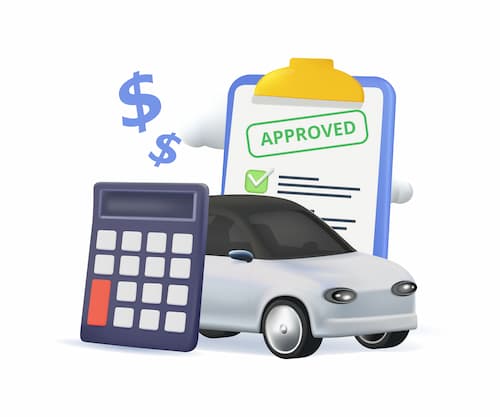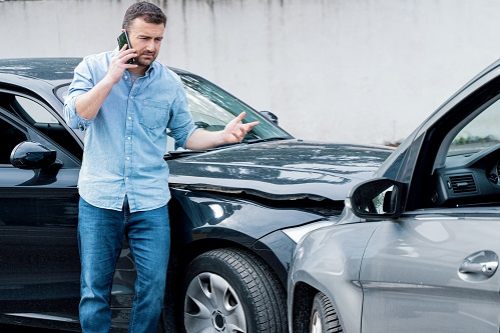- Does insurance cover a hit-and-run?
- What to do after a hit-and-run
- Will a hit-and-run claim raise my insurance?
- Car insurance rates for hit-and-run drivers by state
- Car insurance rates for hit-and-run drivers by age
- How does a hit-and-run affect your insurance in your city?
- What happens if I hit a car and leave?
- Methodology
- Frequently asked question: Hit and run accident
Does insurance cover a hit-and-run?
Car insurance covers hit-and-run accidents, but only if you carry the necessary coverage. Liability insurance does not cover you or your car.
You'll need collision coverage to cover damage to your car from a hit-and-run in most cases.
In a few states, uninsured motorist property damage insurance may cover a hit-and-run. However, uninsured motorist property damage coverage isn't available in all states.
However, in some states, there are exceptions. For example, in Louisiana, if you have an unbiased witness to the hit-and-run, uninsured motorist property damage insurance may cover your losses.
To be covered for injuries, you'll need personal injury protectionPersonal injury protection (PIP) pays for your medical, hospital and funeral expenses resulting from a car accident, regardless of who's at fault. (PIP), medical payments or uninsured motorist bodily injury liability coverageThis auto insurance coverage helps pay for medical expenses and lost wages if you injure someone in a car accident. It also covers legal fees if you're sued.. In some states, these coverages are mandatory; in most, they're not.
If you do not have any medical coverage, many states also have crime victim compensation programs that may help pay medical bills. For example, California has the Victim Compensation Program (CalVCP), and Florida offers Crime Victim Compensation.
What to do after a hit-and-run
After a hit-and-run, make sure everyone is ok, and move the vehicle to a shoulder or safe location if necessary and possible.
Carrie Bonney, a spokeswoman for Farmers Insurance, says you should immediately report the incident to the police.
You will require a police report to file an insurance claim for a hit and run.
You should also:
- Write down a description of the other vehicle and its driver if you saw the accident, including make, model, color and any part of the license plate you may have seen.
- Write down the details of what occurred, including which direction the other vehicle headed after causing the wreck.
- Get the names and contact information of any witnesses.
- Get the names and badge numbers of the police officers who responded.
- Take photos of the accident scene and the vehicles involved, as well as any other property damage.
- Contact any businesses near the accident scene and inquire about any available surveillance camera footage (note that they may only release this to the police).
Will a hit-and-run claim raise my insurance?
If you're the victim of a hit-and-run accident and file a hit-and-run insurance claim, chances are your rates won't increase. Typically, a single not-at-fault collision or uninsured motorist bodily injury claim is unlikely to raise your car insurance.
But if it’s one of multiple claims during the company’s look-back period, usually three years, it could contribute to a rate increase.
| Company | Average annual rate | Rate after hit-and-run (at-fault) | Percent increase |
|---|---|---|---|
| Progressive | $1,998 | $3,066 | 53% |
| State Farm | $1,984 | $3,156 | 59% |
| Travelers | $1,606 | $2,997 | 87% |
| Allstate | $2,509 | $4,895 | 95% |
| USAA | $1,381 | $2,743 | 99% |
| Nationwide | $1,548 | $3,388 | 119% |
| Farmers | $2,387 | $5,311 | 123% |
| GEICO | $1,763 | $4,159 | 136% |
Car insurance rates for hit-and-run drivers by state
If you're convicted of a hit-and-run accident, your car insurance rates are likely to go up by 87%, on average, but could increase by much more, depending on what state you live in, among other factors. You'll see in the table below how much car insurance rates rise after a hit-and-run conviction.
| State | Average annual rate | Rate after hit-and-run (at-fault) | Percent increase |
|---|---|---|---|
| Missouri | $1,982 | $3,037 | 53% |
| Alaska | $1,676 | $2,596 | 55% |
| New York | $1,870 | $2,891 | 55% |
| Texas | $2,043 | $3,194 | 56% |
| Iowa | $1,630 | $2,595 | 59% |
| New Hampshire | $1,265 | $2,024 | 60% |
| Washington, D.C. | $2,157 | $3,474 | 61% |
| Louisiana | $2,883 | $4,649 | 61% |
| Nevada | $2,060 | $3,342 | 62% |
| South Carolina | $2,009 | $3,290 | 64% |
| New Mexico | $2,049 | $3,381 | 65% |
| Florida | $2,694 | $4,514 | 68% |
| Oregon | $1,678 | $2,840 | 69% |
| Idaho | $1,428 | $2,439 | 71% |
| Montana | $2,193 | $3,752 | 71% |
| Utah | $1,825 | $3,119 | 71% |
| Oklahoma | $2,138 | $3,680 | 72% |
| Arizona | $1,812 | $3,130 | 73% |
| Illinois | $1,532 | $2,706 | 77% |
| South Dakota | $2,280 | $4,085 | 79% |
| Tennessee | $1,677 | $2,997 | 79% |
| Wisconsin | $1,664 | $2,986 | 79% |
| Colorado | $2,337 | $4,209 | 80% |
| Georgia | $1,970 | $3,545 | 80% |
| Alabama | $1,860 | $3,369 | 81% |
| Arkansas | $1,957 | $3,539 | 81% |
| Kansas | $1,900 | $3,431 | 81% |
| Indiana | $1,515 | $2,778 | 83% |
| Massachusetts | $1,726 | $3,160 | 83% |
| Maryland | $1,746 | $3,197 | 83% |
| Virginia | $1,469 | $2,683 | 83% |
| Ohio | $1,417 | $2,640 | 86% |
| Delaware | $2,063 | $3,852 | 87% |
| Washington | $1,608 | $3,007 | 87% |
| Pennsylvania | $1,872 | $3,512 | 88% |
| North Dakota | $1,665 | $3,149 | 89% |
| New Jersey | $1,902 | $3,616 | 90% |
| Wyoming | $1,758 | $3,345 | 90% |
| Kentucky | $2,228 | $4,249 | 91% |
| West Virginia | $2,005 | $3,864 | 93% |
| Mississippi | $2,008 | $3,891 | 94% |
| Maine | $1,175 | $2,347 | 100% |
| Vermont | $1,319 | $2,664 | 102% |
| Nebraska | $1,902 | $4,053 | 113% |
| Rhode Island | $2,061 | $4,490 | 118% |
| Minnesota | $1,911 | $4,183 | 119% |
| Michigan | $2,352 | $5,884 | 150% |
| Connecticut | $1,725 | $4,383 | 154% |
| California | $2,416 | $7,486 | 210% |
| Hawaii | $1,517 | $5,296 | 249% |
| North Carolina | $1,741 | $6,902 | 296% |
Car insurance rates for hit-and-run drivers by age
Rates are already high for teens, so it's no surprise that teens involved in a hit-and-run have the highest rates of all age groups. An 18-year-old driver will pay nearly double the rate charged to a 25-year-old driver after a hit-and-run.
| Age group | Average annual rates | Average monthly rates |
|---|---|---|
| Teen (18yr) | $9,011 | $751 |
| Young Adults (25yr) | $4,577 | $381 |
| Adults (40yr) | $3,885 | $324 |
| Seniors (65yr) | $3,671 | $306 |
How does a hit-and-run affect your insurance in your city?
Take a look at your state below to compare car insurance rates in major cities for drivers with a hit-and-run.
| City | Average annual rate | Average monthly rates |
|---|---|---|
| Allakaket | $2,648 | $221 |
| Anchorage | $3,036 | $253 |
| Cordova | $2,491 | $208 |
| Craig | $2,184 | $182 |
| Houston | $2,862 | $239 |
| Juneau | $2,160 | $180 |
| Kodiak | $2,397 | $200 |
| Petersburg | $2,173 | $181 |
| Valdez | $2,521 | $210 |
| White Mountain | $2,650 | $221 |
What happens if I hit a car and leave?
Leaving the scene of an accident is against the law. Every state requires that drivers stop after an accident to exchange information or render aid if needed.
That applies even in parking lots. Security cameras and eyewitnesses lead to more arrests than you might guess. If you're caught, expect to pay for both the damage to the other person’s car and for the crime of leaving the scene.
A hit and run may be a misdemeanor or a felony. It’s more likely to be a felony if someone has been injured. Criminal penalties can include fines of as much as $20,000 and up to 15 years in prison. Even as a misdemeanor, you could face significant fines and up to a year in jail.
There are administrative penalties as well. In New Jersey, for example, leaving the scene of a property damage accident is 2 points on your motor vehicle record; if there’s an injury, the penalty is 8 points.
A conviction for leaving the scene may trigger an SR-22 requirement in many states as well.
Methodology
Insurance.com commissioned rates from Quadrant Data Services in 2022 with the sample profile of a 40-year-old make driver with a 2023 Honda Accord LX. Rates are based on full coverage of 100/300/100 with $500 deductibles.
Frequently asked question: Hit and run accident
Will a hit-and-run claim raise my insurance in California?
No, your rates won't go up if you are the victim of a hit-and-run.
What is a 'miss and run'?
A miss-and-run is a term used for an accident that is caused by another driver who then leaves the scene, but there is no contact with the car. For example, if a car cuts you off and causes you to veer of the road and hit a pole, but that car never touched you, it's a miss-and-run.



